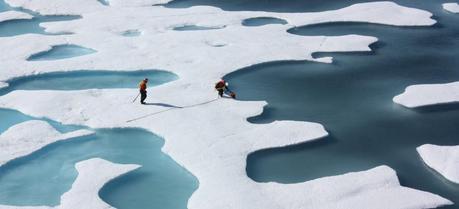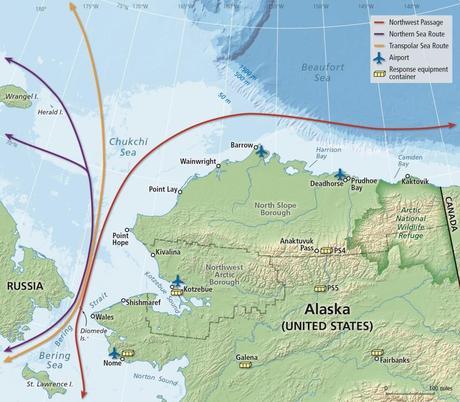 Researchers on the NASA-funded ICESCAPE mission—Impacts of Climate on Ecosystems and Chemistry of the Arctic Pacific Environment—examining melt ponds, the ice around them, and the waters below. (Credit: NASA Goddard Space Flight Center)
Researchers on the NASA-funded ICESCAPE mission—Impacts of Climate on Ecosystems and Chemistry of the Arctic Pacific Environment—examining melt ponds, the ice around them, and the waters below. (Credit: NASA Goddard Space Flight Center)A changing climate is increasing the accessibility of U.S. Arctic waters to commercial activities such as shipping, oil and natural gas development, and tourism, raising concern about the risk of oil spills.
A new report from the National Research Council says that a full suite of proven oil response tools is needed to address potential oil spills in U.S. Arctic waters, but not all of them are readily available. While much is known about both oil behavior and response technologies in ice-covered environments, there are areas where additional research would enable more informed decisions about the most effective response strategies for different Arctic spill situations, the report adds.
The Arctic poses several challenges to oil spill response, including extreme weather and environmental settings, limited operations and communications infrastructure, a vast geographic area, and vulnerable species, ecosystems, and cultures. The report finds that there is a need to validate current and emerging oil spill response technologies under these real-world conditions, and recommends that carefully controlled field experiments that release oil in the U.S. Arctic be conducted as part of a long-term, collaborative Arctic oil spill research and development program that spans local, state, and federal levels.
A decision process such as the Net Environmental Benefit Analysis, which weighs and compares the advantages and disadvantages of different response options, should be used to select the response tools that offer the greatest overall reduction of adverse environmental harm, the report says. Key response options include biodegradation, chemical dispersants and herders, in situ burning, and mechanical containment and recovery. While in situ burning is pre-approved for use in the Arctic under defined conditions, Alaska has not granted pre-approval for use of chemical dispersants.
Research areas that would improve science-based decisions about the use of response technologies include determining the biodegradation rates of hydrocarbons in offshore environments and which strategies can accelerate oil degradation; evaluating the toxicity and long-term effects of dispersants and dispersed oil on key Arctic marine species; and communicating the limitations of mechanical recovery in both open water and ice.

Arctic shipping routes, Alaska Department of Environmental Conservation (ADEC) spill response equipment depots, and villages and towns with the capacity to land passenger jets in Alaska. (Credit: National Research Council)
Due to the range of conditions typically encountered within the Arctic, no single technique will apply in all situations, and in some cases a viable response option might be no response. A combination of countermeasures, rather than a single response option, may provide optimal protection, and so the response toolbox requires flexibility to evaluate and apply multiple options if necessary, the report says.
Building U.S. capability for Arctic oil spill response will also require additional infrastructure. The report finds that current personnel, equipment, transportation, communication, navigation, and safety resources for overseeing a spill response in the Arctic are not adequate, and calls this absence of infrastructure a “significant liability” in the event of a large oil spill. It suggests that positioning response equipment such as aerial in situ burn and dispersant capabilities in the region in advance of a spill would provide immediate access to rapid response options. Furthermore, the U.S. Coast Guard’s presence and performance capacity in the Arctic should be enhanced.
Given the proximity of U.S. Arctic waters to international territories, certain factors should be addressed in advance of an actual event, including communications between command centers, coordinated planning, trans-boundary movement of people and equipment, and identification of translators, the report says. While formal contingency planning and exercises with Canada have been established, the U.S. Coast Guard should expand its bilateral agreement with Russia to include Arctic spill scenarios and conduct regularly scheduled exercises to establish joint response plans, the report recommends.
The Coast Guard should work with the Alaska Department of Environmental Conservation to develop an oil spill training program for local communities and trained response teams in local villages. They should also integrate local and traditional knowledge of ice and ocean conditions and marine life to enhance oil spill response, the report says.
The study was sponsored by the U.S. Arctic Research Commission, American Petroleum Institute, U.S. Coast Guard, U.S. Department of the Interior, Bureau of Ocean Energy Management, Bureau of Safety and Environmental Enforcement, Marine Mammal Commission, National Oceanic and Atmospheric Administration, Oil Spill Recovery Institute, and the National Academy of Sciences.
High-resolution maps from the report and several report briefs are available for download.

